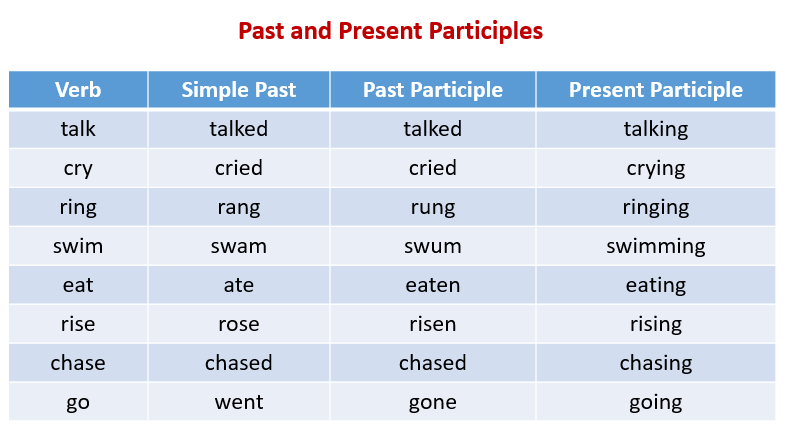
The order of the words in the sentence is the same as with regular past tense questions: the auxiliary verb comes before the subject, and the main verb comes after the subject.įor example, “ He did not walk to school” becomes “ Did he not walk to school?” Another example is “ I did not see the movie,” becomes “ Did I not see the movie?” It’s important to remember that the word “ not” comes after the auxiliary verb and before the main verb. To form negative past tense questions in English, you will need to use the auxiliary verb “ did” and the negative adverb “ not” before the main verb. (The participle phrase describes 'her tutor. (Remember that participle phrases function as adjectives.) Peering over the top of his glasses, her tutor shook his head.

Past participle spanish sentence examples how to#
How To Form Negative Past Tense Questions Printable Test Examples of Participle Phrases In each of these examples, the participle phrase is shaded and the participle is in bold. For example, if the sentence in the past tense is “ I walked to the store,” the question would be, “ Did you walk to the store?” The auxiliary verb “ did” is used to create the question, and the subject “ I” has been inverted with the verb “ walked.” It is important to remember that auxiliary verbs are necessary to form questions in English, and the past tense form of the main verb should always follow the auxiliary verb. Once you have the past tense verb, invert the subject and verb order to form a question. For irregular verbs, the past tense form must be memorized. For regular verbs, you simply add “-ed” to the base form of the verb. To create a past tense question, you must first begin with a past tense verb. What was the first concert you went to?ĭownload Worksheet How To Form Past Tense Questions.When did you last have an argument with someone?.What did you have for dinner yesterday?.What did you do during the winter vacation?.What did you learn at school yesterday?.Where did you go for your last vacation?.These are great to help your students practice speaking in the past tense, or can be used as past tense writing prompts. The player was caught up in it.Here are 25 past questions that you can ask your students. Example: Los jugadores estaban emocionad os. The table below shows past participle endings for masculine and feminine in singular and plural. When the past participle functions as an adjective, it agrees in number and gender with the subject. Examples: encubrir → encubierto descubrir → descubierto componer → compuesto posponer → pospuesto proponer → propuesto revolver → revuelto resolver → resuelto devolver → devuelto deshacer → deshecho prever → previsto Modification of the participle These derivatives follow the same patterns when forming their past participles. This is where a prefix (en-, des-, pos-, etc.) is added to the irregular verb to create a verb with a new meaning. Many of the irregular verbs in the table above have derivative forms. The games were stopped.Įxample: El partido quedó suspendido. Here are some examples: Many verbs have irregular past participles. It is formed by adding the suffix ado to (ar) verbs and ido to (er) and (ir) verbs. I wouldn’t like to play in a team coached by him.Įxample: Los partidos fueron suspendidos. The participio (past participle) is a non-finit verb or a 'verbal' that has the characteristics of an adjective. No me gustaría estar en un equipo entrenado por él. With the game finished, we hurried to the locker room. Because of the heavy rain…Įxample: Terminado el partido, nos fuimos corriendo al vestuario. as a preposition or conjunction: dado (que), visto que, debido a.The spectators at the game were caught up in it.

Los asistentes al partido estaban emocionados. This past Saturday we played the final round in the football league. This tense is used in phrases that denote a period of time such as: El otro da -> The other day.

…we could only have lost.Įxample: El sábado pasado jugamos la última jornada de la liga de fútbol. 7) How to conjugate the Spanish Imperfect Past tense. in the compound tenses with the verb have, such as: perfect, past perfect, preterite perfect, future perfect and conditional perfect in indicative and perfect and past perfect in the subjunctive:Įxample: … solo habríamos conseguido perder.The past participle (also known as participio pasado or participio pasivo) is one of the non-finite verb forms in Spanish grammar.

Past participle (participio pasado) When to use the past participle in Spanish


 0 kommentar(er)
0 kommentar(er)
